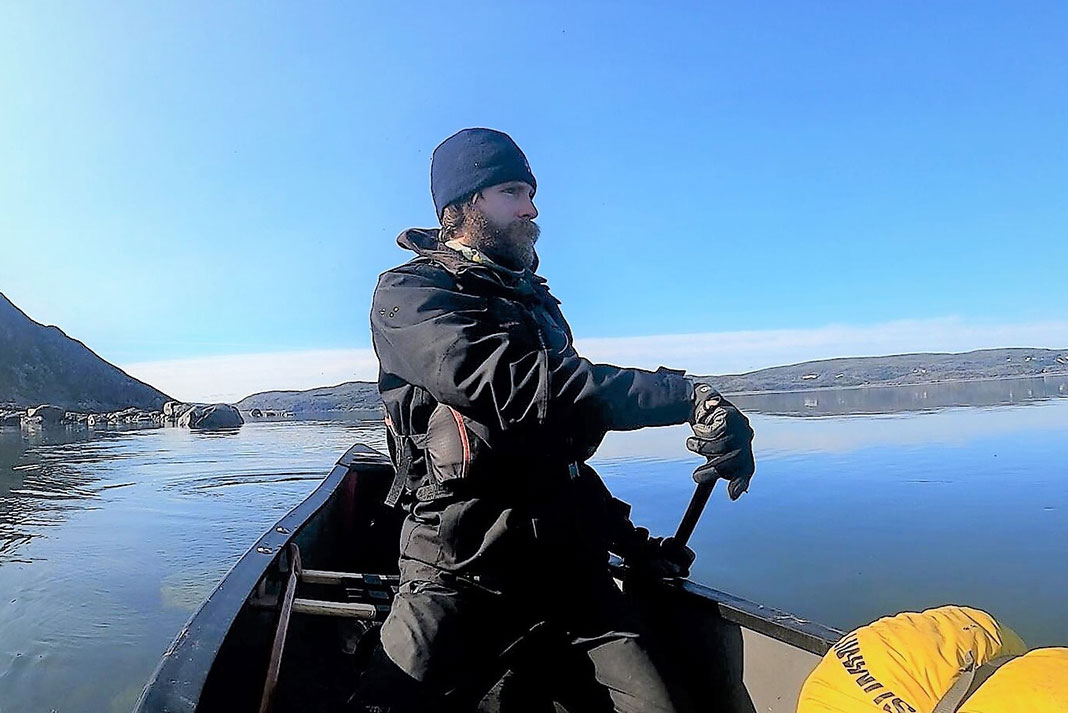
On a foggy day in July 2022, adventurer Adam Shoalts found himself clinging to a moss-covered granite crag in the Torngat Mountains in Labrador. It was an unlikely climax to a three-month, 3,400-kilometer canoe expedition from Lake Erie to Ungava Bay, yet it was exactly where Shoalts intended to be. His arduous journey had traced the path of peregrine falcons, from their migrational stopovers on Lake Erie’s shores to nesting sites in coastal Labrador. Now, Shoalts had left his canoe on the shores of the George River and trekked far inland in search of a falcon nest, the ultimate objective of his journey.
Inside Adam Shoalts’ 3,400-km journey from Lake Erie to Ungava Bay
Shoalts has garnered a reputation roaming the wilderness and spinning yarns about his sometimes esoteric quests. The British newspaper The Guardian called him “Canada’s Indiana Jones” for a project to document an unmapped waterfall on an obscure river flowing into James Bay, which yielded his first bestseller, Alone Against the North. He followed that up with many more adventures and several books, including Beyond the Trees, Shoalts’ account of his 4,000-kilometer west to east canoe expedition from the Yukon to Nunavut’s Hudson Bay coast in the summer of 2017.
Where the Falcon Flies is Shoalts’ latest title, which documents the trip that led him to that moss-covered granite crag in the Torngat Mountains.
Inspiration for the peregrine epic came on an “ordinary April day” at his home in St. Williams, Ontario, near Lake Erie. Shoalts glanced out the window and “spotted a peregrine falcon flying over the neighboring field.”
“The area near our place is a major birding hot spot, so spotting falcons isn’t that uncommon,” Shoalts recalls. “But living in Southern Ontario, there are times when the Arctic feels unconnected to anything local. The falcon made me realize that isn’t really the case. Each spring, falcons migrate from Southern Ontario to the Arctic. So I thought, why not grab my canoe and backpack, and follow that falcon from our doorstep to the Arctic?”
Shoalts’ motivation was also practical: starting from home would save on travel costs.
“Plus, I really liked the idea of exploring the connections between wild places, from the local woods right in my backyard to Arctic mountains, and everywhere in between,” he adds.
Under bridges and along urban shorelines
Setting off, he immediately encountered what could’ve been the expedition’s greatest challenge: portaging around Niagara Falls. But other than crowds of gawkers and a couple of concerned police officers who “thought [he] might be doing something dangerous,” Shoalts says the 13-kilometer portage followed an easy paved trail and took only five hours to complete.
Another problem came in navigating urban shorelines along Lake Ontario and the St. Lawrence River. But even near Toronto, Shoalts says he was able to find secluded copses of trees in which to camp. He also slept a night under the Jacques Cartier Bridge in Montreal and pitched his tent adjacent to Quebec City’s Old Town.
- Paddling past the downtown Toronto skyline… | Photo: Adam Shoalts
- …and under the Jacques Cartier Bridge. | Photo: Adam Shoalts
The tone of the expedition shifted dramatically when he veered north, ascending wild waterways draining into the St. Lawrence to the height of land on the Labrador Plateau. Here he accessed the George River, which flows into Ungava Bay at the Inuit community of Kangiqsualujjuaq.
“I was relieved to get to a wilder section after more than a month of paddling through Southern Ontario and Quebec,” he says. “I just studied maps and traced my finger between places to work out what seemed like the easiest and most straightforward route from point A to point B. Labrador’s interior is so laced with lakes, rivers and ponds, that so long as you don’t get lost, it’s possible to go from pretty much any point to any other.”
Where the falcon flies
Shoalts admits he saw only three peregrine falcons on the three-month journey, perhaps owing to the vast speed difference between a solo paddler and the planet’s fastest animal. He made up for that near journey’s end, when he finally found a falcon’s nest high among the misty ridges of the Torngats.
- The tone of the expedition shifted dramatically when Shoalts veered north. | Photo: Adam Shoalts
- The expedition paddler says the greatest hardship he faced was loneliness. | Photo: Adam Shoalts
“Peregrine falcons nest all across Canada’s Arctic, wherever they can find suitable nesting sites,” he says. “But the sheer cliffs and high peaks of the Torngat Mountains are especially a hot spot for peregrines, and many of the Lake Erie falcons are known to migrate there in particular.”
Unlike his previous expeditions, Shoalts says the greatest hardship he faced was loneliness. Arriving at journey’s end was a huge relief, in stark contrast to the bittersweet emotions he felt at the terminus of his 2017 expedition across Canada’s far north.
“When I did that trip, I wasn’t a parent. Now I am,” he says. “My son was only 14 months when I embarked on this journey, so missing him was definitely the hardest part. I was happy to have finished it and reached the end, but even happier to be going home to my family.”
Shoalts followed the peregrine falcon’s migratory route for his book, Where the Falcon Flies. | Feature photo: Adam Shoalts
I’d love to know the makers of Adam’s canoe cart?
I would love to read the whole article but half of it is obscured by the Paddle Magazine SALE ad
which won’t go away. I have already subscribed.